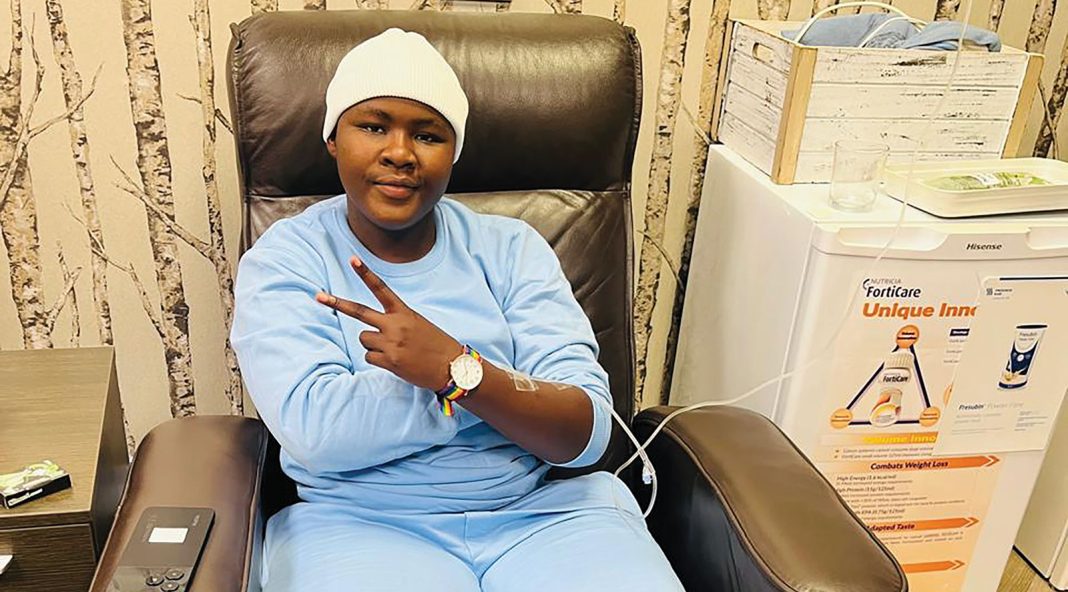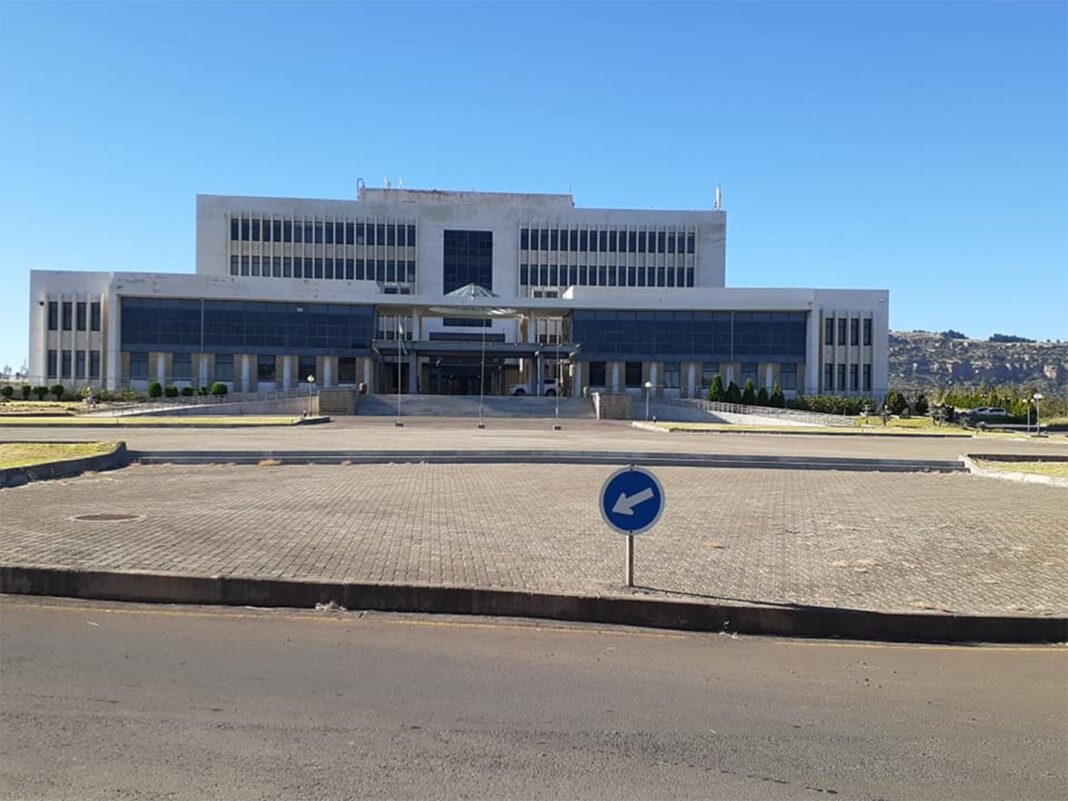At just 21 years old, Litṥoanelo Malataliana has faced a battle that many would find overwhelming. Her journey has been one of immense courage and resilience, having been diagnosed with osteosarcoma, a rare and aggressive form of bone cancer at the tender age of 19.
The disease begins in the cells that form bones. It most often occurs in the long bones that make up the arms and legs, although it can occur in any bone. It tends to occur in children and young adults. Symptoms include localised bone pain and swelling. Treatment typically involves surgery, chemotherapy and radiation.
theReporter recently visited Malataliana at her Maseru West home, as she sat on the couch surrounded by her twin and siblings.
The last born of five siblings explained that she used to be active in sports, particularly football and rugby. She began complaining about pains in her right foot but did not take it to head.
She was doing Grade12 at Life High School at that time. Her foot would get swollen and she would take painkillers for that.
“That was until one time, when my twin said I should actually go to the doctor,” Malataliana recalls.
A scan at Lehlakeng Hospital revealed an abnormality in her bone, leading to a referral to an orthopaedic specialist in Bloemfontein.
The specialist’s suspicion that it might be cancer was soon confirmed by an oncologist, who conducted further tests and ultimately diagnosed Malataliana with osteosarcoma.
The oncologist did a biopsy and in May 3 of 2023 she was amputated.
“After I was diagnosed, all I could think about was death because the cancer was at stage four and had spread to the lungs.
“In January this year, I did a lung ablation which got me into a coma for two weeks. I was discharged in March and continued with treatment.
“I recently did a scan, which showed that three cancer cells had shrunken and only two were left. I cannot breathe properly sometimes, especially when it is cloudy,” she explained.
Her family’s initial disbelief and fear have transformed into unwavering support, although they faced the daunting reality of her amputation.
“According to the doctors, the urgency of the situation necessitated immediate action, preventing any second-guessing that could have jeopardised my chances of survival,” she said.
Malataliana is one of the more fortunate young people; her osteosarcoma was at stage four and spreading to the lungs yet she was able to make it.
According to experts, most cases of stage 1 bone cancer and some stage 2 bone cancers have a good chance of being cured. Unfortunately, stage 3 is more difficult to cure, although treatment can relieve symptoms and slow the spread of the cancer.
A harsh reality is that there are many cases of children in Lesotho who are diagnosed with cancer only when it has reached a more advanced stage.
This was disclosed by the founder of Childhood Cancer Organisation, ‘Mampho Tṥupane who explained that many children who are referred to South Africa to be treated for cancer are always found to have cancer which is already in stage four.
Tśupane revealed that financial constraints often prevent early detection and treatment, saying that families struggle to afford the necessary tests and treatments, resulting in a higher rate of late-stage diagnoses.
Elaborating on the referral process for cancer treatment, she said initially, patients undergo testing at local hospitals such as Queen ‘Mamohato Memorial Hospital.
“If cancer is detected, they are referred to Senkatana and then to Bloemfontein, where more specialised treatment is available at Universitas and National Hospitals.
“In Lesotho, only surgical treatments for some types of cancer are available, while chemotherapy and radiation are conducted in Bloemfontein.
“Unfortunately, not all cancers are treated surgically within Lesotho, and only adults with breast and cervical cancers receive chemotherapy locally.
“The government’s support covers surgeries in Bloemfontein, but families often struggle with additional costs, including transportation, which can delay or prevent treatment,” she explained.
Tṥupane expressed a pressing need for financial assistance and policy changes, particularly advocating for free surgery to alleviate the burden on families.
She recounted a recent tragic case involving a child from Mohale’s Hoek who had kidney cancer, whose condition worsened significantly due to financial barriers preventing timely treatment.
“Unfortunately, not all children can undergo surgery, and access to comprehensive cancer care remains limited,” she said, pointing out that the government provides some support through the ministry of health, but resources are still insufficient for extensive cancer care.
She added that as a result, the local non-profit organisation is calling for public support for cancer survivors and children battling cancer.
The Childhood Cancer Organisation, in its recent statement for Gold September – a month dedicated to raising awareness about childhood cancer – emphasized the need for increased awareness and solidarity with affected families.
Tṥupane said they are still fighting to get statistics of childhood cancer cases, which is proving to be a challenge.
The organisation has urged the public to show support for survivors and children living with cancer.
The Childhood Cancer Organisation made this call in a recent statement to mark Gold September, internationally dedicated to raising awareness about childhood cancer.
The organisation said there was need to continue raising awareness about the impact of childhood cancer including leukemia, brain cancer and lymphomas in families and communities.
According to the World Health Organisation, cancer is one of the leading causes of death among children and adolescents worldwide.
“With leukemia being the most common cancer diagnosed in children, it is essential to come together in solidarity with those affected and work towards better outcome for children with cancer,” it urged.
The Childhood Cancer Organisation also acknowledge the critical role played by health professionals to support children with cancer, and their families.
The organisation believes the ministry is not doing enough to tackle the scourge of childhood cancers and does not treat them as a priority.
However, an advocate for cancer in the ministry of health, Sejojo Phaaroe says the ministry does attach great importance to all the cancers including childhood cancer, hence its celebration at Pitso Ground about its awareness.
Phaaroe said the ministry, though, has capacity limitations when it comes to different types of cancers that is why February 4 is a date marked to celebrate all kinds of cancers because they are just too many.
He said there are over a million types of cancers.
“As government we do not have a budget, we celebrate childhood cancer on February 4also,” he revealed.
Phaaroe stated that the reason why children in Lesotho are mostly diagnosed with cancer when it is already at stage four, should be asked of the minister of health and team at the ministry.
He said previous statistics have shown that there are more than 100 cases.
The most common cancers in children are:
Leukemia
Leukemias, which are cancers of the bone marrow and blood, are the most common childhood cancers. Leukemia can cause bone and joint pain, fatigue, weakness, pale skin, bleeding or bruising, fever, weight loss, and other symptoms. Acute leukemias can grow quickly, so they need to be treated (typically with chemotherapy) as soon as they are found.
Brain and spinal cord tumors
There are many types of brain and spinal cord tumors, and the treatment and outlook for each is different.
Most brain tumors in children start in the lower parts of the brain, such as the cerebellum or brain stem. They can cause headaches, nausea, vomiting, blurred or double vision, dizziness, seizures, trouble walking or handling objects, and other symptoms. Spinal cord tumors are less common than brain tumors in both children and adults.
Neuroblastoma
Neuroblastoma starts in early forms of nerve cells. This type of cancer develops in infants and young children. It is rare in children older than 10. The tumor can start anywhere, but it usually starts in the belly (abdomen), where it is noticed as swelling. It can also cause other symptoms, like bone pain and fever.
Wilms tumor
Wilms tumor (also called nephroblastoma) starts in one or, rarely, both kidneys. It is most often found in children about three to four years old, and it’s uncommon in older children and adults. It can show up as a swelling or lump in the belly (abdomen). Sometimes a child might have other symptoms, like fever, pain, nausea, or poor appetite.
Lymphomas
Lymphomas start in immune system cells called lymphocytes. These cancers most often start in lymph nodes or in other lymph tissues, like the tonsils or thymus. They can also affect the bone marrow and other organs. Symptoms depend on where the cancer starts and can include weight loss, fever, sweats, tiredness (fatigue), and lumps (swollen lymph nodes) under the skin in the neck, armpit, or groin.
Rhabdomyosarcoma
Rhabdomyosarcoma starts in cells that normally develop into skeletal muscle cells. (These are the muscles that we control to move parts of our body.) This type of cancer can start nearly any place in the body, including the head and neck, groin, belly (abdomen), pelvis, or in an arm or leg. It may cause pain, swelling (a lump), or both. This is the most common type of soft tissue sarcoma in children. It makes up about 3% of childhood cancers.
Retinoblastoma
Retinoblastoma is a cancer of the eye. It usually occurs in children around the age of two, and is seldom found in children older than six.
Retinoblastomas are usually found because a parent or doctor notices a child’s eye looks unusual. Normally when you shine a light in a child’s eye (or take a flash picture), the pupil (the dark spot in the center of the eye) looks red because of the blood in vessels in the back of the eye. In an eye with retinoblastoma, the pupil often looks white or pink.
Bone cancers
Cancers that start in the bones (primary bone cancers) occur most often in older children and teens, but they can develop at any age.
Two main types of primary bone cancers occur in children:
Osteosarcoma is most common in teens, and usually develops in areas where the bone is growing quickly, such as near the ends of the leg or arm bones. It often causes bone pain that gets worse at night or with activity. It can also cause swelling in the area around the bone.
Ewing sarcoma is a less common type of bone cancer. It is most often found in young teens. The most common places for it to start are the pelvic (hip) bones, the chest wall (such as the ribs or shoulder blades), or in the middle of the leg bones. Symptoms can include bone pain and swelling.









